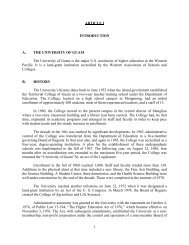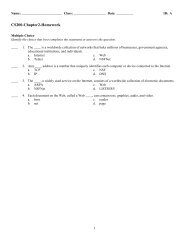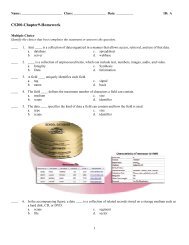Modern compiler design [PDF]
Modern compiler design [PDF]
Modern compiler design [PDF]
Create successful ePaper yourself
Turn your PDF publications into a flip-book with our unique Google optimized e-Paper software.
Chapter 8<br />
Generating Abstract Assembly in C<br />
Chapter Overview<br />
8.1 Creating Abstract Assembly Trees in C<br />
8.1.1 Assembly Language Labels<br />
8.1.2 Interface for Building Abstract Assembly Trees in C<br />
8.1.3 Adding Code to the Semantic Analyzer to Build Abstract Assembly Trees<br />
8.1.4 Functions That Return Abstract Assembly Trees<br />
8.1.5 Variables<br />
8.1.6 Function Prototypes and Function Definitions<br />
8.2 Building Assembly Trees for simpleJava in C<br />
8.2.1 Project Definition<br />
8.2.2 Project Difficulty<br />
8.2.3 Project “Gotcha’s”<br />
8.2.4 Provided Files<br />
8.1 Creating Abstract Assembly Trees in C<br />
To build abstract assembly trees in C, we will first implement an interface that builds assembly trees for<br />
simpleJava statements and expressions, using abstract assembly subtrees. We will then add calls to the<br />
functions defined in this interface to the semantic analyzer, so that the semantic analyzer will build abstract<br />
assembly trees as well as check for semantic errors.<br />
8.1.1 Assembly Language Labels<br />
We will need to generate assembly language labels when building abstract assembly – both for function calls<br />
and for implementing if statements and loops. The file label.h in Figure 8.1 contains prototypes for functions<br />
which allow us to generate both unique labels (such as ifEnd001, ifEnd002, etc), and specific labels (for calls<br />
to library functions, when we know the exact name of the label). The first call to newLabel("foo") returns<br />
the label foo001, the second call returns the label foo002, and so on.<br />
8.1.2 Interface for Building Abstract Assembly Trees in C<br />
The interface for building abstract assembly trees is in Figure 8.2. We will now see some examples of using<br />
these functions to build abstract assembly trees for various statements.<br />
Consider the following simpleJava program:<br />
void foo(int a) {<br />
int b;<br />
int c;<br />
59


![Modern compiler design [PDF]](https://img.yumpu.com/37285279/60/500x640/modern-compiler-design-pdf.jpg)


![Residence Hall Application Form [PDF]](https://img.yumpu.com/46340085/1/190x245/residence-hall-application-form-pdf.jpg?quality=85)










